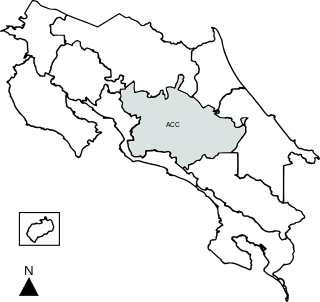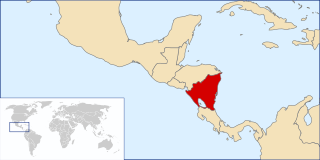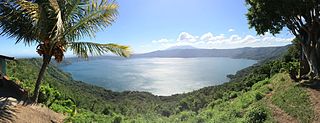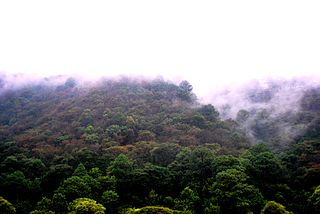
Monteverde is the twelfth canton of the Puntarenas province of Costa Rica. It is located in the Cordillera de Tilarán mountain range. Roughly a four-hour drive from the Central Valley, Monteverde is one of the country's major ecotourism destinations. The area is host to the Monteverde Cloud Forest Reserve and several other natural attractions, which draw considerable numbers of tourists and naturalists.
National System of Conservation Areas is part of the Ministry of Environment and Energy (MINAE) of Costa Rica. It is the administrator for the nation's national parks, conservation areas, and other protected natural areas.

Arenal Tempisque Conservation Area, is an administrative area which is managed by SINAC for the purposes of conservation in the northwest part of Costa Rica, near the Arenal Volcano and covering part of the Cordillera de Tilarán and Cordillera de Guanacaste. It contains a number of National Parks, Wildlife refuges and Protected Zones. The area was previously known as Arenal Tilarán Conservation Area.

Arenal Volcano National Park is a Costa Rican national park in the central part of the country, part of the Arenal Huetar Norte Conservation Area. The park encompasses the Arenal Volcano, the most active in the country, which was believed to be dormant until a major eruption in 1968. It neighbors Lake Arenal, which is the site of the country's largest hydroelectricity project, the Lake Arenal Dam.

Central Conservation Area, is an administrative area which is managed by SINAC for the purposes of conservation in the central part of Costa Rica, notably the volcanic areas of the Cordillera Central. It contains six National Parks, several wildlife refuges and other types of nature reserves.

The protected areas of Chile are areas that have natural beauty or significant historical value protected by the government of Chile. These protected areas cover over 140,000 km2 (54,054 sq mi), which is 19% of the territory of Chile. The National System of Protected Wild Areas is regulated by law #18,362 passed in 1984, and administered by the National Forest Corporation (CONAF).

The fauna of Nicaragua is characterized by a very high level of biodiversity. Much of Nicaragua's wildlife lives in protected areas. There are currently 78 protected areas in Nicaragua, covering more than 22,000 square kilometers (8,500 sq mi), or about 17% of its landmass.
National System of Protected AreasSINAP, is the Nicaraguan national parks administrator, and is part of the Nicaraguan Ministry of Environment and Natural Resources (MARENA).

Tourism in Nicaragua has grown considerably recently, and it is now the second largest industry in the nation. Nicaraguan President Daniel Ortega has stated his intention to use tourism to combat poverty throughout the country.

The following is an alphabetical list of topics related to Nicaragua.
Cerro Arenal Natural Reserve is a natural reserve with an area of 14.28 square kilometres in the Cordillera Dariense, it is located in the Matagalpa department in central Nicaragua.

Laguna de Apoyo Nature Reserve is a nature reserve located between the departments of Masaya and Granada in Nicaragua. Lake Apoyo was declared a nature reserve in 1991 and is managed by the Ministry of the Environment and Natural Resources (MARENA) and comprises one of 78 protected areas of Nicaragua. Activities within the Laguna de Apoyo Nature Reserve are regulated by its management plan, approved in 2010, which prohibits the construction of housing within the reserve and use of motorized vehicles on the lake. Geological data suggests that Lake Apoyo originated about 23,000 years ago.
The Padre Ramos Estuary Natural Reserve is located on the northwest Pacific coast of Nicaragua, in the municipality El Viejo in the department of Chinandega. It is one of 78 protected areas of Nicaragua and is managed by Ministry of the Environment and Natural Resources (MARENA). Estero Padre Ramos consists of a large mangrove estuary surrounded by several small beach communities, the largest of which is the town of Padre Ramos. The area's natural environment is home to a number of species of migratory and resident birds, fishes, crustaceans, sea turtles and other wildlife. While increasing in popularity as a tourist destination, tourism remains relatively well controlled in the area.

The Central American pine–oak forests is a tropical and subtropical coniferous forests ecoregion in the mountains of northern Central America and Chiapas state in southern Mexico.
Estero Real Natural Reserve is a nature reserve in Nicaragua. It is one of the 78 reserves that are under official protection in the country. It is in the Northwest corner of Nicaragua in Chinandega Department and borders the country of Honduras.
Volcán Maderas Natural Reserve is a nature reserve on the island of Ometepe in Nicaragua. The reserve contains Volcán Maderas, an extinct 1,394 volcano surround by a cloud forest, The crater contains a lagoon. The reserve requires that any climbing the volcano hire a guide.
Yulu Natural Reserve is a nature reserve in Nicaragua. It is one of the 78 reserves that are under official protection in the country.

The Central American montane forests are an ecoregion of the tropical and subtropical moist broadleaf forests biome, as defined by the World Wildlife Fund, located in mountains of Central America.
Protected areas of Panama include:
















